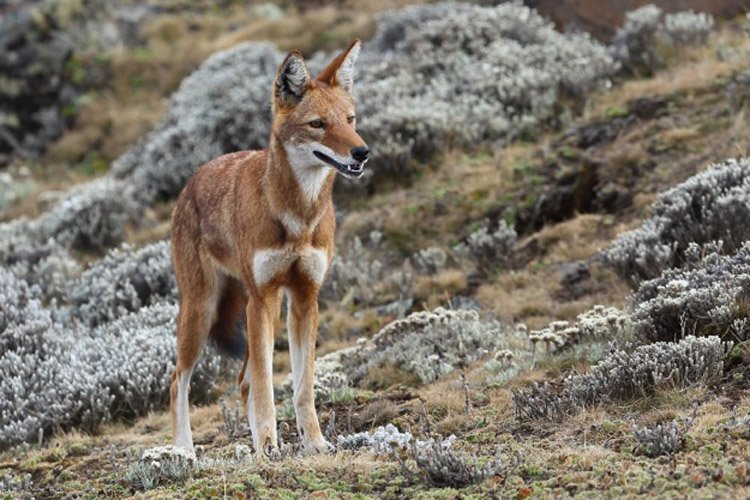Saving the Ethiopian Wolf | Apex conservation priority
Posted by Giovanna Fasanelli
in Of Interest
In this article, Apex co-founder, Giovanna Fasanelli, discusses the Ethiopian Wolf Conservation Program (EWCP). Apex is proud to support EWCP and their work in saving the Ethiopian Wolf.
Saving Ethiopian Wolves from extinction
High up in the wind-blown grasslands and heathlands of Ethiopia lives the world’s most endangered member of the canid (dog) family, the Ethiopian Wolf. Despite appearing more like a jackal or a fox, mitochondrial DNA analysis has revealed the species to have descended from a Gray Wolf-like ancestor that likely wandered across from Eurasia into Africa many moons ago. Here it encountered bountiful rodent hunting grounds in the mountainous regions of what was once known as Abyssinia. Over the millennia, the species adapted its body morphology and developed the specialized hunting techniques required to capitalize on the extraordinary densities of subterranean rodents living in these high-altitude habitats, above 10,000 feet.
Today’s Ethiopian Wolf is a wily, coyote-sized hunter sporting a dashing, rusty-red and white fur coat and a long, narrow muzzle fashioned specifically to ferret quaking rodents out from their dens. Although they live in highly social family groups of up to twenty individuals, and do occasionally band together to hunt larger prey such as antelope, the nature of their favored prey requires them to forage alone. Rodent hunting is a lonely, silent pursuit and one that requires a great deal of patience, but this is how these canids have learned to succeed as the apex predator, one rat at a time. The general technique is to be positioned within striking distance of a rodent colony and wait for the inhabitants to scurry between burrow entrances or to spend time foraging in the open on nearby herbage. The large, finely tuned ears of the wolf work like parabolic reflectors, directed forward to tune in to the slightest rustlings. Once a target has been locked in, the wolf leaps into the air and shoves its long snout into the hole, digging furiously if necessary to reach its quarry, sometimes leaving a sizeable mound of sand in its wake. The wolves have also been observed hunting amongst domestic cattle and grazing Geladas, purportedly in an attempt to obscure their presence as they approach their victims.
Challenges facing Ethiopian Wolf conservation
With such specialized lifestyles and habitat requirements, populations of both the wolf and its prey are suffering under increasing human-induced pressures. The most immediate and worrying threat to the wolves is the dramatic loss of habitat, as well as a significant increase in the presence of livestock that are being grazed on what is left. The thousands of hooves and hungry mouths not only destroy the sensitive plant communities in these areas but they disturb the underground rodent colonies. Most alarming of all, however, is the peril of interactions with feral dogs that accompany the shepherds. These dogs introduce the deadly diseases of rabies, canine distemper and parvovirus, all which have wreaked havoc amongst the remaining genetically isolated populations of wolves, leaving countless carcasses in their path. Now officially Africa’s most endangered carnivore, the survival of the species is currently in the paws of fewer than 500 individuals living in six fragmented populations through the Afro-Alpine highlands of Ethiopia. The largest population, around 50% of the surviving individuals, lives in the austere but stirringly beautiful Bale Mountains in Ethiopia’s south east. It is here that Apex Expeditions brings its travelers every year to observe the wolves as they interact, hunt, rest and play in this strikingly unique ecosystem. And every year, Apex supports the incredible work being conducted by the Ethiopian Wolf Conservation Program.
Ethiopian Wolf Conservation Program
Founded in 1995 by Dr. Claudio Sillero and Dr. Karen Laurenson, the EWCP uses a combination of monitoring, research, education, habitat restoration and protection, and disease control, in an impassioned attempt to curb the wolf’s slide towards extinction. The latest exciting development in the extinction war is the approval of an oral rabies vaccine, the very first time that this vaccine will be used on wild populations of an endangered species, having previously been successful at eradicating rabies from red foxes and raccoons over vast areas in the U.S. and Europe. The vaccine will be hidden in chunks of goat meat and scattered across wolf territory. These oral vaccines represent a proactive approach, getting ahead of the disease, rather than waiting for an outbreak to begin, as in the years of the injected vaccines. Worldwide, rabies kills almost 60,000 humans every year, so working to save the wolves from this unspeakable fate will serve to protect human communities, as well.
In the end, these measures will only help to save the species as long as other project objectives are achieved. This is where habitat protection and education play vital roles going forward. In the meantime, precious donor dollars are going a long way to giving this most elegant species a fighting chance.
Learn More
For more information on the efforts of the Ethiopian Wolf Conservation Program, or to make a contribution, visit: www.ethiopianwolf.org. View our Ethiopia expeditions page to join one of our upcoming expeditions.

